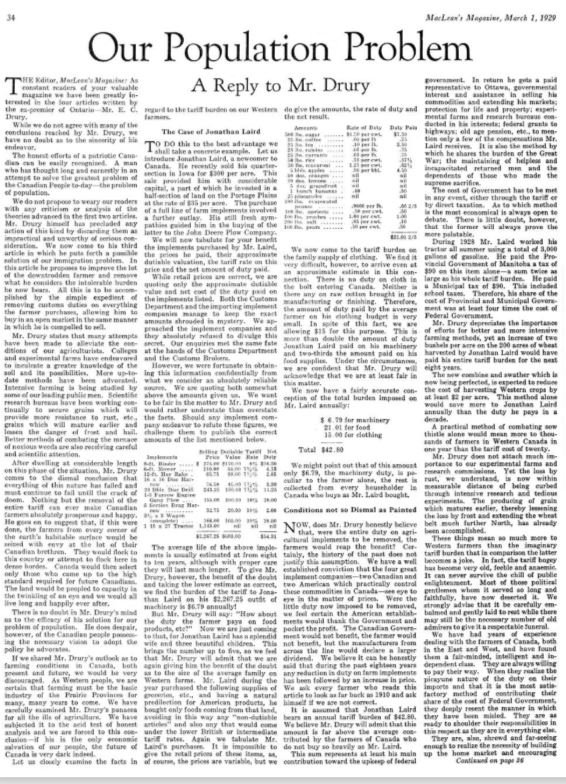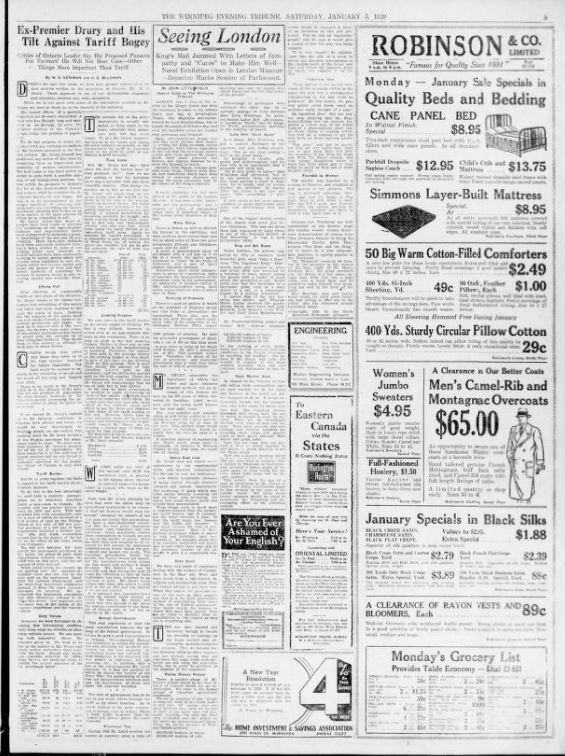The long review of Shaw’s Complete Plays which appeared in the Manitoba Free Press in 1931 is astonishing in setting out the problems and potential solutions which would define McLuhan’s intellectual life for the following half century. It would be even more astonishing if McLuhan himself — then only 19! — did not write the piece, but some unknown mentor instead who was to be forever decisive for his work.
McLuhan highlights Shaw’s critique of contemporary ‘originality’.
“what the world calls originality is only an unaccustomed method of tickling it” (Shaw, Preface to Three Plays for Puritans)
“I am a crow who has followed many ploughs.” (Preface to Three Plays for Puritans)
Everything [Shaw] says points back to Nietzsche, to Ibsen, to Plato, and always he is swift to affirm his debt: “No doubt I seem prodigiously clever to those who have never hopped (…) across the fields of philosophy, politics and art.” (Preface to Three Plays for Puritans)
Our attempts at originality are superficial because they completely overlook its central problem. McLuhan calls it the “constitutional inability to look below the surface”. Our inability to understand Plato and, especially, his considerations of originality — as well as his genial demonstrations of it — are entailed by this deeper deficiency.
[Shaw] would have us look for the “underlying will” that governs ideals, the unconscious desires that urge them into being.
Our very ideals are masks which hide the springs of ideals and, therefore, also the different ideals which would be prompted from different springs.
Mr. Shaw’s philosophy is not away with all ideals, but: “The ideal is dead: long live the ideal.”
That we cannot understand Plato’s originality necessarily rebounds on Shaw and McLuhan themselves. For if they attempt to follow on after him, how should their thoughts be any more intelligible to us than his? Admittedly, McLuhan does nod to Shaw’s hope that we might see through his joking to his underlying intent to prompt thought:
the whole tenor of his plays is impatience with us because we never think; but he can give us a premonition of thinking. He drives the comfortable fogs out of our minds as the prophets of old drove demons out of the possessed, not with rites and incantations, but with railleries and caustic jesting.
Exactly on account of our “constitutional inability to look below the surface”, however, McLuhan emphasizes Shaw’s contrary resignation to “the extreme improbability of anybody seeing anything in my treatise but a paradoxical joke.” Hence:
the device contrived to attract the crowd to the entrance [the “paradoxical joke”, the “railleries and caustic jesting”] now covers the whole show. Its creator cannot get free of it, cannot speak through it to those he is trying to reach. When he leaves off capering and speaks directly, with serious passion and therapeutic wrath, what he gets is an idle clapping of the hands.
McLuhan emphasizes the point, which of course follows directly from our “constitutional inability to look below the surface”, by repeating it, verbatim, in the concluding lines of the review where he speaks of audiences
greeting [Shaw’s] stern wraths as well as his gay frivolities with polite laughter and an idle clapping of the hands.
This “constitutional” superficiality, the fact that “we never think”, may be termed “legend”:
legend obscures the real Shaw, not only from the idealists, who protest that they do not understand him, but from the Shavians, who protest that they do. Shavianism (…) suffers from its ardent converts as well as from its ardent enemies.
We have come to be defined by a lack of communication with the tradition and its greatest minds. At the same time, this is a lack of communication with the springs of our own experience, including our experience of minds like Plato’s. It is the latter deficiency that entails the former one. The problem, then, is one of remedying our “constitutional inability to look below the surface” of our own selves to begin to reconnoiter those springs which are already active in us, but, somehow, only behind our own backs (a remedial process McLuhan would later come to call “retracing”). McLuhan therefore cites Shaw as follows:
To me the tragedy and comedy of life lie in the consequences, sometimes terrible, sometimes ludicrous, of our persistent attempts to found our institutions on the ideals suggested to our imaginations by our half-satisfied passions, instead of on a genuinely scientific natural history. (Preface to Plays Pleasant)
“A genuinely scientific” investigation of our own “natural history” — of what McLuhan came to term, following the French, “the interior landscape” — was McLuhan’s solution to the question of how to reestablish communication with the tradition and with its greatest minds. Of course this remained barely an intimation in 1931. But prompted by his mother’s work as an “impersonator” (which turned on character types), and by the teaching of his Manitoba philosophy professors, Lodge and Wright, that thinking is structured by persistent forms like idealism and realism, and by his beginning acquaintance with Coleridge and his ‘born’ Platonists and Aristotelians, McLuhan’s idea, even at nineteen, was that the investigation of such types might provide a way back to an appreciation of originality (beginning with our own).
McLuhan’s reading of Shaw (which could be applied to anybody) was plainly derived from his mother’s one-woman theatre:
[Shaw] divides his personality into a hundred appallingly articulate Proteuses (…) so that the entire stage of our time is populated with bits and multiples and off-shoots of Shaw
It is a small step (one that McLuhan’s mother consciously suggested in her “impersonations”) to wonder how each of these characters might think about virtue and religion, or organize a state, or consider “being itself”. But this was, of course, just what Plato portrayed over and over again in his dialogues. The tradition itself, then, would teach how access to it is first of all possible and how this access must be cultivated — if it were not exactly this access that has been lost!
The as yet inchoate (but somehow obvious) notion was — “the medium is the message”. What ideal or unconscious desire or spring would it take to enable us to get ‘in touch’, once more, with our “potencies” (as McLuhan would call them in his letter to Harold Innis in 1951) and, through them, with the entire tradition? McLuhan would come to his signature expression, “the medium is the message”, in 1958, more than a quarter century in the future from 1931. And yet the notion is already there in germ in his Shaw review waiting, even demanding, to be clarified and developed.
Further, McLuhan already knew what it is that cuts us off from the imperatively needed investigations of “potencies”:
The whole point and substance of Shaw’s teaching are that he is content, that he is in favor of this whirlgig process [of time] that will inevitably bring him to negation.
The reason for our “constitutional inability to look below the surface” is that “negation” stands (if negation may be said to stand or in any way to be!) between us and the potentialities or “potencies” of the subterranean “interior landscape”. It is possible to investigate possibilities, plural, only by letting go of the singularity of the presently activated one:
[Ideals aka “potencies”] must conform, not to the arbitrary shape our self-full longings would impose upon them, but to the nature of things. And “nature does not dance to moralist-made tunes.”
“Negation” is the border, or “no man’s land” (as McLuhan will later say), between any individual point of view or character or part (in a play) or “put-on” and the whole range of views, characters, parts and put-ons which are available for human beings and constitute, in McLuhan’s terminology, the unconscious. Being able to to immerse oneself in the question posed by this range is what McLuhan took to be the “negative capability” of Keats. In his 1943 ‘Aesthetic Pattern in Keats Odes’ he described this capability as:
a mode of being which Keats himself called “negative capability“. Keats’ definition of this phrase (…): “. . . when a man is capable of being in uncertainties, mysteries, doubts, without any irritable reaching after fact & reason.”
“Fact & reason” presuppose some ground determined (consciously or not) by some singular point of view. To consider the range of points of view therefore requires a tolerance of “uncertainties, mysteries, doubts, without any irritable reaching after fact & reason”.
More, between such basic “potencies” is further “negation” — for the borders between fundamentals cannot themselves be fundamentals. They must be abysmal gaps of “negation” in the range of possibilities — the unconscious — itself.
Already in 1931, it seems, McLuhan had his project (“understanding media”) and a clear view of the role “negation” — or “the gap” — must have on the way to its realization. Somehow “content[ment]” and “favor” would have to be communicated in regard to our ineluctable confrontation with that “negation” in order to expose its transitivity or metaphoricity. This was the precondition of his and our entering into the project at all.
He never succeeded with us, of course. But perhaps he was not wrong that the fate of the world hung on this matter?


